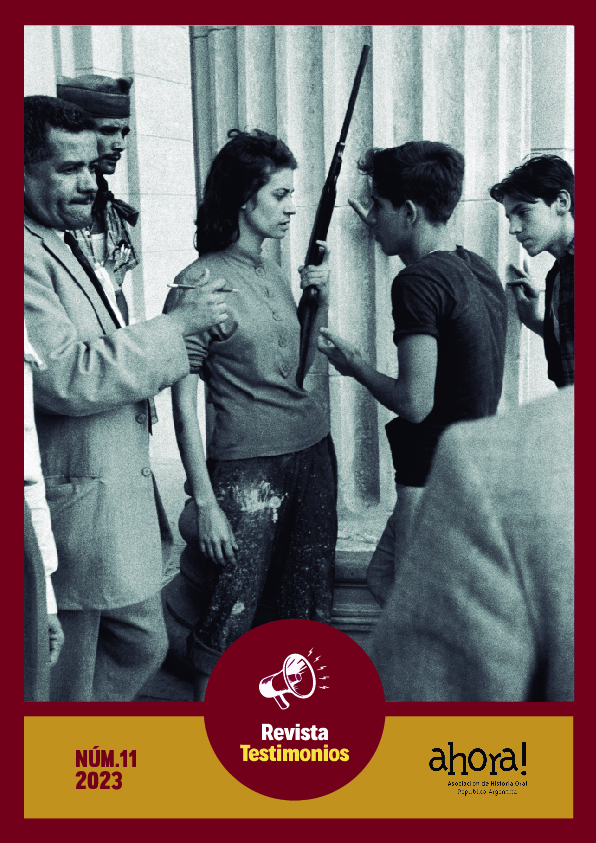Childhood memory in three generations of Mexico City in the twentieth century: from the word said to the recovered memory
Keywords:
Oral history, Orality, Experience, Generation, Memory, ChildhoodAbstract
Oral history has not been sufficiently inclined to recover the memory about childhood and childhood memory, despite the cultural significance that is recognized in this field of research. Notwithstanding that this discipline has become a privileged window to recover the history of the subaltern groups. The purpose of this text is to recreate the childhood experiences between members of several generations of Mexico through oral testimonies. The protagonists of contribute with their stories to illuminate a fragment of childhood history in Mexico. Both lived for much of their childhood in Moderna Colonia, located in the limits of the geographical center of Mexico City. The territory where they develop their childhood life was founded and expanded in the late 1920s and early the following. In those childhood memories, he recalls to boys and girls who were born and grew up in a city that redefined its contours as a result of the urbanization processes that produced different places and multiple panoramas that outlined a new architecture that intermingles a city and strong traditions that take root in the rural world and the birth of a megalopolis. The territory where they develop their childhood life was founded in the late 1920s and early the following. The questions that guide this text are: How and what is remembered? how is the individual story(s) organized and how, based on these, a collective narrative is recreated, social memory is made insofar as it is representative of a specific social group and at the same time it can be a history of a society, in particular of children's culture?
References
Alonso, A. (2011). “Prólogo”, en: Aguilar Sahagun, G. El hombre y los materiales. México: D.F., FCE, SEP, CONACYT.
Burke, P. (2000). Historia y teoría social (Traducción Stella Mastrangelo). México: Instituto Mora.
Buendía, H. (2016). “El Oriente de la Delegación Benito Juárez, rico en historia, 9 de marzo de 2016/Libre en el Sur”, Disponible en: htpps://libreenelsur.mx/ [consultado el 8 de marzo de 2019].
Braunstein, N. (2012a). La memoria, la inventora. México: Siglo XXI Editores.
Braunstein, N. (2021b). La memoria del uno y la memoria del Otro: inconsciente e historia. México: Siglo XXI Editores.
Certeau, M., y Giard, L. (1999). “Envío”, en: Michel de Certeau, La invención de lo cotidiano 2: habitar, cocinar. México: Universidad Iberoamericana.
Chmiel, F. (2020). Las Casas de Sal: espacialidad y afecto en las memorias de las infancias en el exilio, Sociedad e Infancias, Vol. 4, Universidad Complutense. EN https://revistas.ucm.es/index/php/SOCI/issue/archive. [Consultado en agosto de 2022].
Dutrénit Bielous, S. (2015). Aquellos niños del exilio. Cotidianidades eentre el Cono Sur y México. México: Instituto Mora.
Halbwachs, M. (2011). La memoria colectiva. Buenos Aires: Miño y Dávila.
Jelin, E. (2014). Las múltiples temporalidades del testimonio: el pasado vivido y sus legados presentes, Clepsidra. Revista Interdisciplinaria de Estudios sobre Memoria, N° 1, p. 140-163.
Koselleck, R. (1993). “Espacio de experiencia y horizonte de expectativa. Dos categorías históricas”, en: Reinhart Koselleck, Futuro pasado. Para una semántica de los tiempos históricos. Barcelona: PAIDÓS.
Marinas, J. (2007). La escucha en la historia oral. Palabra dada. Madrid: Editorial Síntesis.
Martin Criado, E. (2009). “Generaciones/Clases de edad”, en: Reyes, R. (Dir), Diccionario Crítico de Ciencias Sociales. Terminología Científica y Social, Tomo 1/2/3/4. Madrid-México: Plaza y Valdés. Disponible en: https://webs.ucm.es/info/eurotheo/diccionario/ficha/htm. [Consultado en agosto de 2022].
Martínez Omaña, M. (2004). “Construcción y representación social del Lugar”, en: de Garay, G. (Coord.), Modernidad habitada: Multifamiliar Miguel Alemán, Ciudad de México, 1949-1999. México: Instituto Mora.
Martínez Omaña, M. (2009). “Prácticas y representaciones sociales en torno al abastecimiento, disponibilidad y aprovechamiento del agua en la Ciudad de México, 1940-2000”, en: Martínez Omaña, M. (Coord.), El agua en la memoria. Cambios y continuidades en la Ciudad de México, 1940-2000. México: Instituto Mora.
Mendes Dos Santos, Brandao Veríssimo, Carolina, SSra, Rodrigues Cardoso, Paloma. (2021). “¿Dónde está la infância que estuvo aquí? ¡El gato se comió! Reflexiones sobre el tiempo e infancia”, Sociedad e Infancias, Vol. 5, N° 1. Disponible en: https://revistas.ucm.es/index.php/SOCI/aoi. [Consultado en agosto de 2022].
Miodownik, M. (2017). Cosas (y) materiales. La magia de los objetos que nos rodean. Madrid: Turner.
Moreira Lópes, J. (2021). La geografía de la infancia, los niños, las niñas y sus infancias: desafíos, Cuadernos de la infancia. Revista de investigación interdisciplinaria sobre el protagonismo y los derechos humanos de las infancias latinoamericanas, N° 2, septiembre. Disponible en: https://cuadernosdelainfancia.el//2019/13/la-geografía-de-la infancia-los niños-las niñas-y-sus infancias-desafíos/ [Consultado en agosto de 2022].
Padilla Arroyo, A. (2006). Memorias y vivencias de la muerte y la orfandad, Secuencia, N° 66.
Pereda, C. (2012). “Sobre el posible continuo personal-social de la memoria”, en: Schmidt-Welle, F. (Coord), Culturas de la memoria. Teoría, historia y praxis simbólica. México: Siglo XXI Editores.
Pollak, M. (2006). Memoria, olvido, silencio. La producción social de identidades frente a situaciones límite. La Plata: Ediciones Al Margen.
Pussetto, M. (2021). ¿Qué le vas a decir a la Historia? Experiencias de infancias en un hogar escuela durante la década de 1950, Testimonios, Año 10, N° 10. Disponible en: https://revistas.ucm.edu.ar/index.php/testimonios/index. [Consultado en agosto de 2022].
Thompson, P. (1988). La voz del pasado. Historia oral. Valencia: Edicions Alfons El Magnànim. Institució Valenciana D’Estudis I Investigació.
Vásquez, J. (2011). El ruido de las cosas al caer. México: Alfaguara.
Vázquez, F. (2001). La memoria como acción social. Relaciones, significados e imaginario. Barcelona: PAIDÓS.
Downloads
Published
Issue
Section
License
Copyright (c) 2022 Antonio Padilla Arroyo

This work is licensed under a Creative Commons Attribution-NonCommercial-ShareAlike 4.0 International License.
No se permite un uso comercial de la obra original ni de las posibles obras derivadas, la distribución de las cuales se debe hacer con una licencia igual a la que regula la obra original.





.png)






